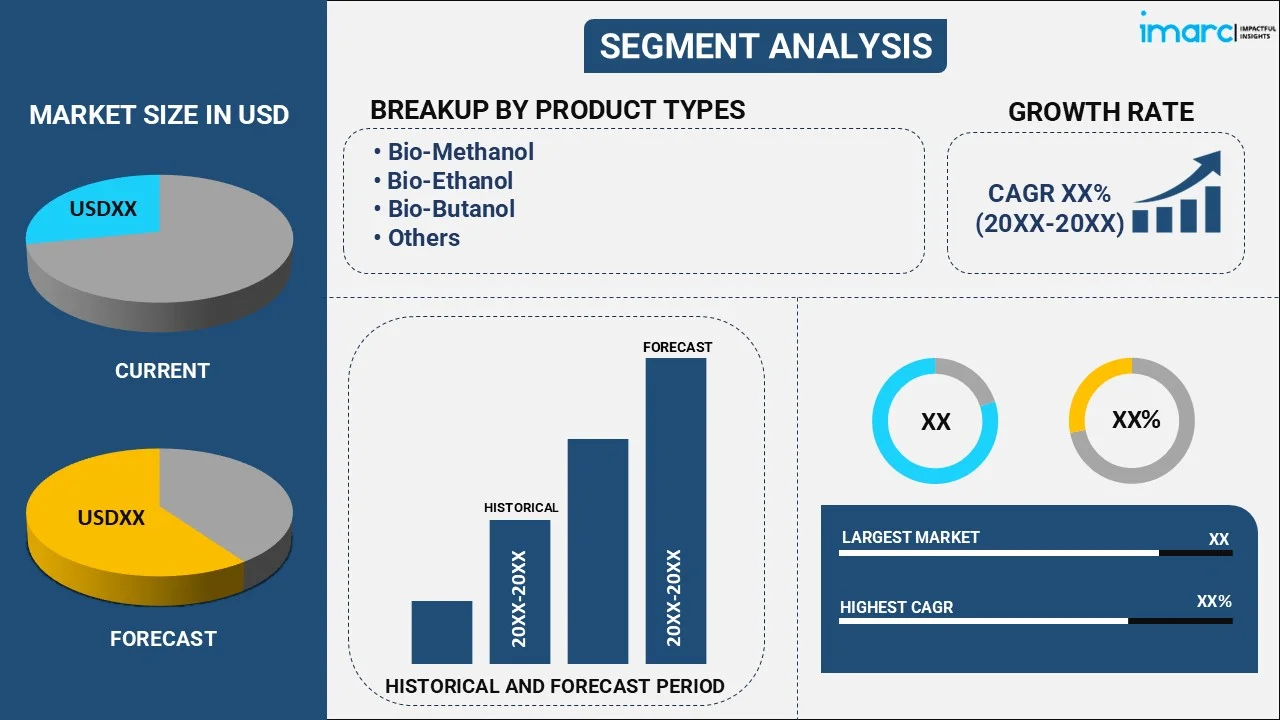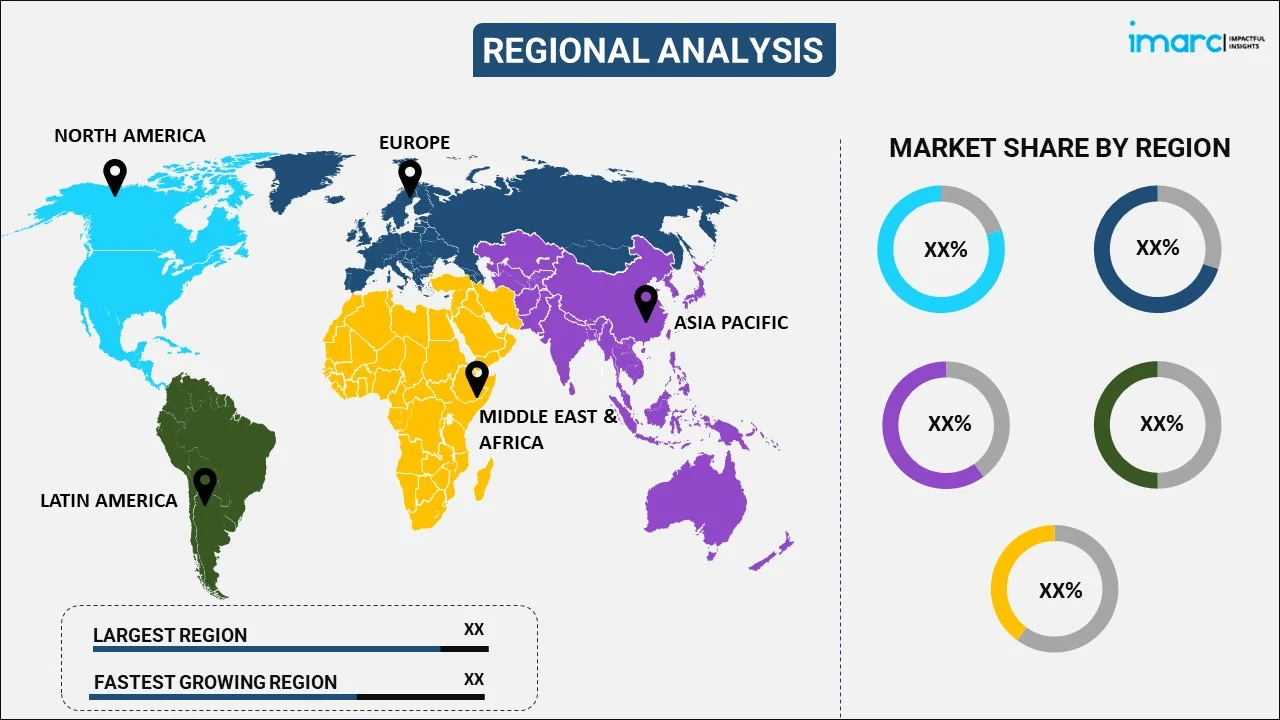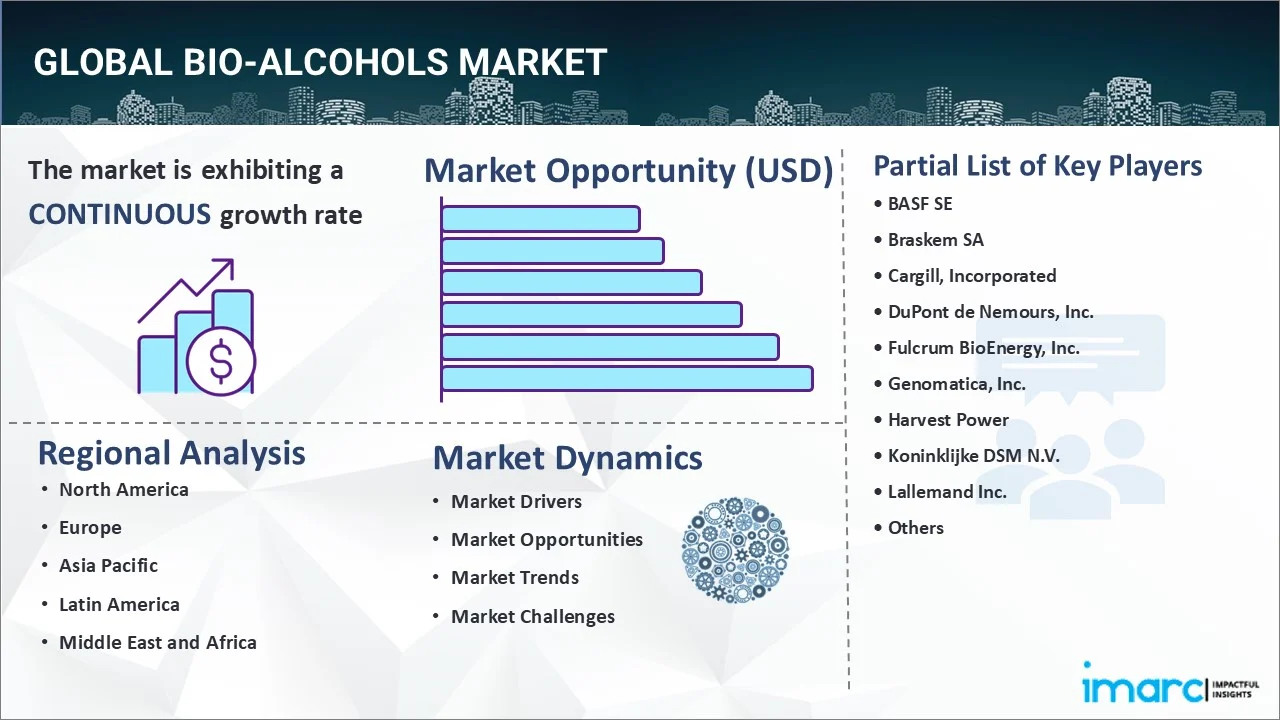
Bio-Alcohols Market Report by Product Type (Bio-Methanol, Bio-Ethanol, Bio-Butanol, Bio-BDO, and Others), Raw Material (Grains, Sugarcane, Industrial Beets, Biowaste, and Others), Application (Transportation, Construction, Medical, Power Generation, and Others), and Region 2025-2033
Bio-Alcohols Market Size:
The global bio-alcohols market size reached USD 15.4 Billion in 2024. Looking forward, IMARC Group expects the market to reach USD 33.7 Billion by 2033, exhibiting a growth rate (CAGR) of 8.63% during 2025-2033. The market is primarily driven by increasing environmental issues, government regulations promoting renewable energy, advancements in biofuel technologies, rising crude oil prices, and the growing demand for sustainable and eco-friendly alternatives in transportation and industrial applications.
|
Report Attribute
|
Key Statistics
|
|---|---|
|
Base Year
|
2024
|
|
Forecast Years
|
2025-2033
|
|
Historical Years
|
2019-2024
|
| Market Size in 2024 | USD 15.4 Billion |
| Market Forecast in 2033 | USD 33.7 Billion |
| Market Growth Rate 2025-2033 | 8.63% |
Bio-Alcohols Market Analysis:
- Major Market Drivers: The bio-alcohols market is driven by the increasing environmental issues and the need to reduce greenhouse gas emissions. These factors are prompting governments worldwide to implement regulations and incentives promoting the use of renewable energy sources. Advances in biofuel technologies are making bio-alcohol production more efficient and cost-effective. Rising crude oil prices also make bio-alcohols a more attractive alternative. Additionally, growing consumer awareness and demand for sustainable and eco-friendly products in transportation and industrial applications are further fueling market growth, encouraging more investment and research in the bio-alcohol sector.
- Key Market Trends: Several bio-alcohols market trends are shaping the industry such as a significant shift toward second-generation bio-alcohols, which are produced from non-food biomass, reducing competition with food supply chains. Integration of advanced fermentation technologies and genetic engineering is enhancing production yields and efficiency. Additionally, strategic partnerships and collaborations between biofuel companies and agricultural sectors are increasing, aimed at securing sustainable raw material supplies. The rising focus on achieving net-zero emissions by 2050 is also enhancing investments in bio-alcohol research and development.
- Geographical Trends: North America dominates the bio-alcohols market as the region has substantial agricultural resources, providing ample raw materials for bio-alcohol production. Strong governmental policies and incentives supporting renewable energy adoption and carbon reduction goals are also significant drivers. The U.S. and Canada are key contributors, with significant investments in biofuel infrastructure and research initiatives.
- Competitive Landscape: Some of the major market players in the bio-alcohols industry include BASF SE, Braskem SA, Cargill, Incorporated, DuPont de Nemours, Inc., Fulcrum BioEnergy, Inc., Genomatica, Inc., Harvest Power, Koninklijke DSM N.V., Lallemand Inc., Mitsubishi Chemical Holdings Corporation, PTT Global Chemical Public Company Limited, and Valero Marketing and Supply Company, among many others.
- Challenges and Opportunities: High production costs and competition with fossil fuels pose significant hurdles. Technological advancements and economies of scale are essential to making bio-alcohols more economically viable. Additionally, there are concerns about the sustainability of feedstock supplies and the environmental impact of large-scale bio-alcohol production. However, advances in genetic engineering and fermentation technologies can improve production efficiency. The growing focus on circular economy practices and the development of integrated biorefineries offer the potential for reducing costs and enhancing sustainability, creating a more robust and resilient bio-alcohol market.
Bio-Alcohols Market Overview:
Technological Advancements in Bio-Alcohol Production
Recent technological advancements have significantly impacted the bio-alcohol market. Innovations such as genetically modified microorganisms have enabled the production of bio-alcohol from non-food sources like waste materials and cellulose. Additionally, new fermentation processes have increased production yields, making bio-alcohol production more efficient and cost-effective. These advancements are crucial as they reduce dependency on food crops, thereby addressing food security concerns and promoting sustainability. Governments worldwide have also introduced policies to encourage the use of biofuels, contributing to market growth. For instance, the U.S. Department of Energy supports research and development in bioenergy technologies, emphasizing advancements in converting biomass into biofuels. Significant investments in R&D are expected to drive the bio-alcohols market revenue.
Growing Demand in the Transportation Sector
The transportation sector is the fastest-growing segment in the bio-alcohol market, driven by the need to reduce greenhouse gas emissions and improve air quality. Bio-alcohols like bioethanol and bio-methanol are increasingly used as renewable fuels in gasoline and diesel engines. Policies and regulations such as renewable fuel standards and biofuel blending mandates are being implemented globally, which boosts the demand for bio-alcohols. According to the U.S. Energy Information Administration, the Renewable Fuel Standard (RFS) program requires transportation fuel sold in the U.S. to contain a minimum volume of renewable fuels, which includes bio-alcohols. This regulatory support is expected to further propel the bio-alcohols market growth.
Regional Market Dynamics and Government Initiatives
The bio-alcohol market exhibits significant regional variations, influenced by local government policies and initiatives. Europe, for example, holds a substantial market share, driven by the European Union’s targets to increase the use of renewable energy in transportation. The region's well-developed infrastructure for producing and distributing biofuels supports this growth. In Asia-Pacific, countries such as China and India are witnessing rapid market expansion due to the rising demand for alternative fuels and supportive government initiatives. For instance, India's National Policy on Biofuels aims to achieve a 20% ethanol blending target by 2025. Such initiatives are expected to drive substantial growth in the market across different regions and increase bio-alcohols demand.
Bio-Alcohols Market Segmentation:
IMARC Group provides an analysis of the key trends in each segment of the market, along with bio-alcohols market forecast at the global, regional, and country levels for 2025-2033. Our report has categorized the market based on product type, raw material, and application.
Breakup by Product Type:

- Bio-Methanol
- Bio-Ethanol
- Bio-Butanol
- Bio-BDO
- Others
Bio-ethanol accounts for the majority of the market share
The bio-alcohols market report has provided a detailed breakup and analysis of the market based on the product type. This includes bio-methanol, bio-ethanol, bio-butanol, bio-BDO and others. According to the report, bio-ethanol represented the largest segment.
Bio-ethanol is the largest segment in the bio-alcohols market due to its widespread use as a renewable fuel. It is commonly blended with gasoline to reduce greenhouse gas emissions and enhance energy security. Bio-ethanol is also favored for its ability to be produced from various feedstocks, including corn, sugarcane, and cellulose, making it versatile and scalable. Government mandates and incentives play a significant role in driving demand. For example, the U.S. Environmental Protection Agency (EPA) mandates a renewable fuel standard, requiring a certain volume of renewable fuels, including bio-ethanol, to be blended into transportation fuel. This regulatory support, along with technological advancements, has solidified bio-alcohols market outlook.
Breakup by Raw Material:
- Grains
- Sugarcane
- Industrial Beets
- Biowaste
- Others
Grains holds the largest share of the industry
A detailed breakup and analysis of the market based on the raw material have also been provided in the report. This includes grains, sugarcane, industrial beets, biowaste and others. According to the report, grains accounted for the largest market share.
Grains hold the largest share of the market due to their abundant availability, cost-effectiveness, and high fermentable sugar content, which makes them optimal for bio-ethanol production. The efficient conversion of grains into bio-alcohols supports a sustainable energy source, reducing reliance on fossil fuels. According to the United States Department of Agriculture (USDA), in 2022, U.S. ethanol production totaled about 15.4 billion gallons, with a significant portion derived from corn, demonstrating the critical role that grains play in this industry. This prominence is further bolstered by advances in agricultural technology and bioprocessing methods, enhancing yield and efficiency, thereby significantly contributing to the growth and stability of the bio-alcohols market.
Breakup by Application:
- Transportation
- Construction
- Medical
- Power Generation
- Others
Transportation represents the leading market segment
The report has provided a detailed breakup and analysis of the market based on the application. This includes transportation, construction, medical, power generation and others. According to the report, transportation represented the largest segment.
Transportation represent the leading application segment due to the extensive use of bio-alcohols as renewable fuels. They help reduce greenhouse gas emissions and enhance energy security. Government mandates and incentives, such as the Renewable Fuel Standard (RFS) in the United States, require increasing volumes of biofuels to be blended with gasoline, boosting bio-alcohol demand in transportation applications. This, coupled with advancements in production technologies and the push for cleaner, sustainable fuel alternatives, solidifies the transportation sector as a key segment in the bio-alcohols market.
Breakup by Region:

- North America
- United States
- Canada
- Asia Pacific
- China
- Japan
- India
- South Korea
- Australia
- Indonesia
- Others
- Europe
- Germany
- France
- United Kingdom
- Italy
- Spain
- Russia
- Others
- Latin America
- Brazil
- Mexico
- Others
- Middle East and Africa
North America leads the market, accounting for the largest bio-alcohols market share
The report has also provided a comprehensive analysis of all the major regional markets, which include North America (the United States and Canada); Europe (Germany, France, the United Kingdom, Italy, Spain, Russia, and others); Asia Pacific (China, Japan, India, South Korea, Australia, Indonesia, and others); Latin America (Brazil, Mexico, and others); and the Middle East and Africa. According to the report, North America was the largest regional market for bio-alcohols.
As per the bio-alcohols market research report, North America boasts a robust agricultural base, particularly in corn production, which is the primary feedstock for bio-ethanol. Additionally, strong regulatory support enhances market growth. The RFS mandates in the U.S. require increasing volumes of biofuels to be blended into the nation's fuel supply, further driving demand for bio-alcohols. The region's advanced infrastructure and technological advancements in bio-alcohol production also play crucial roles in increasing the market growth.
Competitive Landscape:
- The market research report has also provided a comprehensive analysis of the competitive landscape in the market. Detailed profiles of all major companies have also been provided. Some of the major market players in the bio-alcohols industry include BASF SE, Braskem SA, Cargill, Incorporated, DuPont de Nemours, Inc., Fulcrum BioEnergy, Inc., Genomatica, Inc., Harvest Power, Koninklijke DSM N.V., Lallemand Inc., Mitsubishi Chemical Holdings Corporation, PTT Global Chemical Public Company Limited, and Valero Marketing and Supply Company.
(Please note that this is only a partial list of the key players, and the complete list is provided in the report.)
- The bio-alcohols market is highly competitive, with several bio-alcohols companies driving innovation and expansion. Major companies are focusing on technological advancements, strategic partnerships, and expanding production capacities to maintain their market positions. For instance, on 22 July 2024, BASF SE has achieved ISCC+ certification across all its global major production sites for acrylics, alcohols, glycol ethers, and acetates, taking an important step to support customers in fulfilling their targets and ambitions. With this step, BASF is now able to produce more than 60 products related to this portfolio with one or more sustainability attributes.
Bio-Alcohols Market News:
- On February 2, 2023, Prof. V. S. Moholkar, Adjunct faculty of School of Energy Science and Engineering and Professor, Department of Chemical Engineering at IIT Guwahati and his research group have developed lab-scale know-how for producing bio-alcohols like bioethanol and biobutanol from waste invasive weeds that are ubiquitous in northeast India. Prof. Moholkar's group has developed the sonic fermentation technique for synthesis of bio-alcohols from mixed invasive weeds, which is not only faster than conventional fermentation, but also gives higher yields.
- On April 3, 2024, BIO India has officially launched its premium range of domestically produced Bio-Liquor products in Hyderabad, heralding a new era in the spirits industry.
Bio-Alcohols Market Report Scope:
| Report Features | Details |
|---|---|
| Base Year of the Analysis | 2024 |
| Historical Period | 2019-2024 |
| Forecast Period | 2025-2033 |
| Units | Billion USD |
| Scope of the Report | Exploration of Historical Trends and Market Outlook, Industry Catalysts and Challenges, Segment-Wise Historical and Future Market Assessment:
|
| Product Types Covered | Bio-Methanol, Bioethanol, Bio-Butanol, Bio-BDO, Others |
| Raw Materials Covered | Grains, Sugarcane, Industrial Beets, Biowaste, Others |
| Applications Covered | Transportation, Construction, Medical, Power Generation, Others |
| Regions Covered | North America, Asia Pacific, Europe, Latin America, Middle East and Africa |
| Countries Covered | United States, Canada, China, Japan, India, South Korea, Australia, Indonesia, Germany, France, United Kingdom, Italy, Spain, Russia, Brazil, Mexico |
| Companies Covered | BASF SE, Braskem SA, Cargill, Incorporated, DuPont de Nemours, Inc., Fulcrum BioEnergy, Inc., Genomatica, Inc., Harvest Power, Koninklijke DSM N.V., Lallemand Inc., Mitsubishi Chemical Holdings Corporation, PTT Global Chemical Public Company Limited, and Valero Marketing, Supply Company, etc. |
| Customization Scope | 10% Free Customization |
| Post-Sale Analyst Support | 10-12 Weeks |
| Delivery Format | PDF and Excel through Email (We can also provide the editable version of the report in PPT/Word format on special request) |
Key Benefits for Stakeholders:
- IMARC’s industry report offers a comprehensive quantitative analysis of various market segments, historical and current market trends, market forecasts, and dynamics of the bio-alcohols market from 2019-2033.
- The research report provides the latest information on the market drivers, challenges, and opportunities in the global bio-alcohols market.
- The study maps the leading, as well as the fastest-growing, regional markets. It further enables stakeholders to identify the key country-level markets within each region.
- Porter's five forces analysis assists stakeholders in assessing the impact of new entrants, competitive rivalry, supplier power, buyer power, and the threat of substitution. It helps stakeholders to analyze the level of competition within the bio-alcohol industry and its attractiveness.
- The competitive landscape allows stakeholders to understand their competitive environment and provides insight into the current positions of key players in the market.
Key Questions Answered in This Report
The global bio-alcohols market was valued at USD 15.4 Billion in 2024.
We expect the global bio-alcohols market to exhibit a CAGR of 8.63% during 2025-2033.
The growing adoption of biofuels in automobiles, owing to the increasing need for minimizing carbon emission levels, is primarily driving the global bio-alcohols market.
The sudden outbreak of the COVID-19 pandemic has led to the rising utilization of bio-alcohols for producing bioethanol-based hand sanitizers and disinfectants to combat the spread of the coronavirus infection.
Based on the product type, the global bio-alcohols market can be segmented into bio-methanol, bio-ethanol, bio-butanol, bio-BDO, and others. Currently, bio-ethanol holds the majority of the total market share.
Based on the raw material, the global bio-alcohols market has been divided into grains, sugarcane, industrial beets, biowaste, and others. Among these, grains currently exhibit a clear dominance in the market.
Based on the application, the global bio-alcohols market can be categorized into transportation, construction, medical, power generation, and others. Currently, transportation accounts for the majority of the global market share.
On a regional level, the market has been classified into North America, Asia Pacific, Europe, Latin America, and Middle East and Africa, where North America currently dominates the global market.
Some of the major players in the global bio-alcohols market include BASF SE, Braskem SA, Cargill, Incorporated, DuPont de Nemours, Inc., Fulcrum BioEnergy, Inc., Genomatica, Inc., Harvest Power, Koninklijke DSM N.V., Lallemand Inc., Mitsubishi Chemical Holdings Corporation, PTT Global Chemical Public Company Limited, and Valero Marketing and Supply Company.
Need more help?
- Speak to our experienced analysts for insights on the current market scenarios.
- Include additional segments and countries to customize the report as per your requirement.
- Gain an unparalleled competitive advantage in your domain by understanding how to utilize the report and positively impacting your operations and revenue.
- For further assistance, please connect with our analysts.

 Inquire Before Buying
Inquire Before Buying
 Speak to an Analyst
Speak to an Analyst
 Request Brochure
Request Brochure
 Request Customization
Request Customization




.webp)




.webp)












